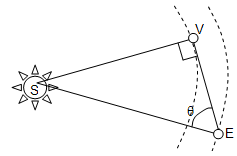Storytelling Science
Be an ancient astronomer
Amitabha Mukerjee
Imagine yourself in some ancient ashrama in Vedic times. After the sun goes down, out come the stars. Remember, there are no electric lights, and animal-fat candles are rare.Night after night, you gaze up at the stars as the heavens turn in a giant pirouette, beautiful and mysterious. Most of the stars seem fixed in this rotating dome, but some objects, like the sun, the moon and a few pinpoints, move. The moon shifts about a "fist" every night, and if you study the heavens carefully, you realize that the sun moves about a "span" every month. The others - Venus, Jupiter, Saturn - are less regular.
Now - this is the same sky you see above you every night, even today!

Locate your sun sign with your fist
If you find a cloud-free night this week, you can try this ancient trick using your fist as an astronomical instrument. If you have a friend born in late July or early August, then you can surprise her by showing her "sun sign", the constellation Leo, in the sky. The brightest object in the evening sky these days is Jupiter (look to the west). Beneath it is Regulus, the brightest star in Leo (maghaa to the ancients) - just stretch out your arm and measure the width of your fist below Jupiter, and you will find maghaa, and thereby, the constellation Leo!
On another side of the heavens is the great bear or saptarshi, the big "question-mark" shaped constellation of the Northern skies. The top two stars of Saptarshi are well known as a pointer to the Pole star (dhruv). The distance between the Great Bear and the pole star is one span - the outstretched measure from the thumbtip to little finger (approx. 25 degrees). Now, what is interesting is that if you were to extend the same line backwards then you reach Leo about two spans on the other side from the pole star.

When the observed angle of Venus from the Sun is maximum, the triangle SVE is right angled and distance SV = SE. sin(θ).
Giovanni Cassini: Measuring the heavens
In the next months you will hear a good bit about the Cassini probe which is now exploring the satellites of Saturn. It is named after Giovanni Cassini, an astronomer who in 1671, measured Mars' position against the fixed stars from two sides of the Atlantic, and used this information to compute the distance between the earth and the sun.
Recently, some schoolkids computed something very similar - they worked out the orbital radius of Venus using some simple angle measurments. Astronomer Nirupama Raghavan of Chennai coordinated this Vamana Project, with participation from Jaipuria School in Kanpur and some schools in Chennai. The children simply observed the angle between Venus and the Sun (called "elongation"), around the time in March when this angle was highest. The maximum was about 46.5 degrees, which makes the orbital radius of Venus 0.725 that of the earth, an error of only 0.2%.

Now, wouldn't science be more exciting if one could measure the heavens? These articles are intended so that you, the adult reader, can point some of these things out to youngsters . . . and you have no excuse, for all you need are your hands (and eyes)!